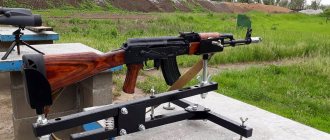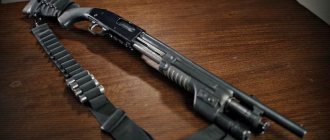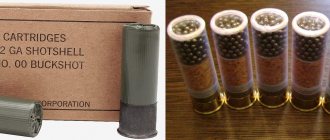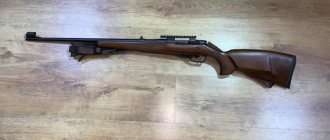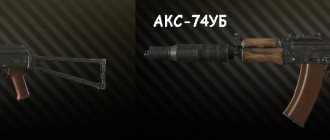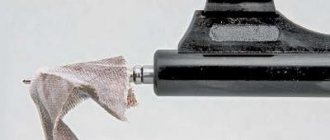The issue of care and cleaning of smooth-bore weapons is very important, because... Sooner or later, corrosion and lead attacks any metal. This should be prevented in advance. The weapon must be systematically wiped down, the remaining lead, soot and acid residues must be removed from the weapon. The weapon also needs to be thoroughly oiled.
Maintenance and cleaning are carried out in order to extend the operating time of the weapon. During the cleaning process, you get rid of sand, dust or old dried grease. The main thing is to remember that the lubricant in which the weapon is sold - the manufacturer's lubricant - is not intended for the normal operation of the weapon, therefore, first of all, when purchasing a weapon, it is worth removing this particular lubricant.
And directly, after the first shots, it is necessary to clean the weapon on the same day (which few people do!), in smooth-bore weapons, gently immediately after the shots, at least remove the carbon deposits.
Cleaning the gun
Nowadays, there are a variety of products from popular manufacturers - sprays, polishes and all kinds of oils. First you need to disassemble the weapon, the barrel bores with alkaline spray foam, you also need to spray the ejector mechanism, the muzzle and the receiver with the end.
To achieve maximum effect, the foam should be left for 20-30 minutes. You need to clean the spray with a clean cotton cloth; you need to wrap the cloth around a cleaning rod with a visor to remove the alkali. After cleaning, the barrels must be wiped dry. Next, rub neutral oil into the barrel and wipe everything dry again.
The most important thing is cleaning the barrel; you need to clean each barrel of the weapon with a metal brush. Proper cleaning from the chamber to the muzzle. At the end of cleaning, it is necessary to remove all traces of alkali, oil stains and wipe all parts of the weapon. But there are several ways to clean weapons without using expensive sprays and oils.
The easiest way to clean a weapon is to thoroughly wipe the barrels with the most common neutral oil. Using available household products, you can also take good care of your weapon. For example, you can make cotton swabs, soak them in vinegar and leave them in the barrel of a weapon for 15-20 minutes, and then lubricate them with oil.
Handling a gun while hunting
To reduce the likelihood of contamination of your gun and extend its service life, you need to handle it correctly while hunting. If it falls to the ground, you must immediately check whether soil or snow has gotten into the bores and, if necessary, clean them. When firing from a contaminated barrel, there is a risk of it swelling or bursting. When loading the gun after shooting, you need to check whether there is a wad, a cartridge case that has come off the cap, or part of it left inside.
Important! You cannot add a bird or animal with a weapon and deliver shot game to them from the water. The result of such actions may be its damage.
During a rest, the gun needs to be unloaded, cut off a tree branch so that a small part of it remains on the trunk, and hang it on it, pointing the trunks down. If a shotgun or carbine is leaned against a tree, it may fall to the ground.
Cleaning a gun is a very responsible process that often causes difficulties for beginners. However, it is important to do it regularly to keep the gun in good technical condition. Cleaning the weapon after shooting ensures its proper operation and extends its service life.
Recipe for gun cleaning composition
There is another option for cleaning a gun: you need to take boiling water with washing powder pre-mixed in it and dip the ends of the barrels into this solution. This procedure should be repeated for 5 minutes. After this, we dry the trunks and wipe the metal surface with oil. After a few days, it is worth repeating this procedure.
After repeating this cleaning twice, wipe the barrels with a cotton rag and lubricate them with neutral oil. If hunting will take place in rainy weather, or in conditions of high humidity, it is better to wipe the gun with silicone grease.
What to do if the weapon is rusty?
If the metal parts of the gun are covered with rust, do not despair. To correct such a defect, various products are sold in gun stores, but first, the rust must be removed using hard brushes and metal brushes. In this case, it is advisable to pre-moisten them with kerosene.
If there is a lot of rust inside the barrel and it is difficult to remove, you need to place the corroded metal in a bath and then pour kerosene inside the barrel. In this case, the barrel must be closed with a tight-fitting plug so that the liquid does not spill out. The weapon should remain in this condition for at least a day. After this, the rust will come off easily if you use a brush and a wire brush.
Systematic gun care
In between hunts, the gun also needs to be looked after; it needs to be wiped and lubricated. Because During storage, moisture, dust and dirt get inside the barrel. It is also worth remembering that even if you do not use a weapon, but it hangs aimlessly on the wall or lies in a safe, it is still worth cleaning and caring for it systematically. At least wipe the metal parts outside.
The weapon should be stored in a dry, dark place, at room temperature and normal air humidity.
How to clean a gun: step-by-step instructions
Absolutely any firearm, regardless of its caliber, operating principle and type of ammunition used, requires careful care, regular cleaning and lubrication.
Otherwise, it may misfire at the most crucial moment, fail, which will entail serious expenses, or even become a threat to life! How to clean a hunting rifle, what rules must be followed and what do you need to know about cleaning and lubricating weapons?
Why do hunting weapons get dirty?
The reasons why a hunter's weapon becomes dirty are quite obvious. Forests, steppes, swamps, fields do not in any way resemble a scientific laboratory or a sterile hospital ward.
No matter how carefully the gun is used during hunting, no matter how comfortable the conditions are when it is transported, its metal parts in the open air will inevitably come into contact with moisture and other unfavorable factors.
And if you are unlucky with the weather or the weapon falls out of your hands...
In addition, cleaning the gun is necessary for another reason. The fact is that when fired, the barrel experiences high pressure and high temperatures.
Hot gases and particles of burning gunpowder lead to the formation of “rashes” on the inner surface of the barrel - small pockets of rust that tend to further develop into shells.
Soot from black powder has the property of attracting moisture.
In addition, cleaning smooth-bore weapons, like rifled weapons, allows you to get rid of soot, scale and so-called copper plating - residues of particles of a bullet or other ammunition in the bore. And although there is no universal answer to the question of how to properly clean a hunting rifle, it is strongly recommended to follow the basic principles.
When to clean
There is a fairly common misconception that says that frequent cleaning is harmful to the gun, as it leads to scratches, abrasion of chrome surfaces, and so on.
It should be noted that if you neglect basic tips on how to properly clean a gun, then an expensive weapon can break down much faster - within a couple of years. Experts recommend cleaning your weapon at least once a month, even if it has not been used.
In addition, there are strong recommendations, including from manufacturers, when cleaning is simply necessary:
- after purchasing a new gun;
- in the process of shooting it;
- after every hunt;
- at the end of the season.
Load ammo correctly
Use only correctly loaded cartridges, which means that under no circumstances should you exceed the charges established for the given caliber and weight of the weapon. For God’s sake, don’t listen to all these so-called “experienced hunters” who tell miracles about the firing of their guns with reinforced charges. It’s simply amazing how persistent the misconception is that the stronger the charge, the better the fight. It came to us from the common hunting habits of the last century. Then, for long and heavy ramrods, homemade by eye with a multiple safety margin, a one-and-a-half or even two-fold increased charge of black powder was not scary, and the cannon roar and puffs of smoke, combined with lethal recoil, made an indelible impression on their inexperienced owners. If you still managed to shoot something, then another hunting legend is ready. In fairness, it must be said that for strong and long-barreled weapons, when using black powder, as an exception, a slight increase in the charge can be allowed in order to increase range, but in modern guns and with smokeless powders, in no case.
Black hunting powder
Smokeless powder is much stronger than smoky, or as it is also called, black. If you put one and a half times more black powder in a cartridge, then the pressure developed during a shot will be one and a half times higher, or two times higher. With smokeless or nitro powders everything is much more complicated; the force of the charge does not grow in proportion to its weight, but much faster. Only completely irresponsible people can advise you to put a charge of, for example, 3 grams of Sokol smokeless powder into a 12-gauge cartridge. I often had to listen in different places in our country: “I put three grams of smokeless substance under a bullet, well, it hits! Force!". I agree, the fight turns out to be strong and sharp, with the butt hitting the shoulder, or even the face. The point is that the burning rate of gunpowder is constant, and, accordingly, excess gunpowder will not have time to burn out in the barrel in the short time that the charge moves along the barrel bore. These excesses burn out at the very end of the barrel tube and beyond and do not have time to transfer a useful impulse to it. In return, they manage to raise the pressure in the barrel to dangerous levels, create an excessive load on all components of the gun, and, breaking out of the barrel at great speed and turning the gun into some kind of rocket, transfer a powerful reactive impulse back to it and crack the shooter on the shoulder. An excessively large charge of gunpowder can cause rupture of the barrel or destruction of certain components of the gun. I know an old hunter whose right eye was knocked out by the bolt of a Berdan gun in his youth. The bolt was thrown out of the receiver by an excessive charge of gunpowder. Thank God, he remained alive and spent the rest of his life shooting from his left shoulder.
Use the ammo recommended for your weapon
The length of the cartridges must match the chamber of the gun. The length of the chamber is indicated both on the gun itself and in its passport. Modern shotguns have chamber lengths of 70 mm (23/4 inches) and 76 mm (3 inches). Among the old guns there are examples with 65 mm chambers. Accordingly, cartridges come in different lengths. You cannot use cartridges longer than the chamber, since in this case, when firing, a pressure surge that is dangerous for the gun occurs immediately behind the chamber. I myself had a curious incident happen a year ago. I accidentally loaded my TOZ-34 with 70 mm chambers with imported bullet cartridges designed for 76 mm chambers. When shooting, I was surprised by the brutal recoil, I also thought: “The bourgeoisie make evil cartridges!”, but I could not open the gun - the bolt was jammed. Cartridges shorter than chambers can be used without fear.
Chambered for 76 mm
If a cartridge in a folder (cardboard) sleeve is swollen and does not fit into the barrel, you should not try to drive it there and forcefully close the gun, it will not take long to break the under-barrel hook, and unnecessary extra load will be placed on the axial bolt. It also happens the other way around: on a rainy autumn day, the cartridge in the barrel becomes damp and does not come out of the chamber, preventing the gun from being opened. You shouldn’t even try to open it by force (some try to do it through the knee), nothing good will come of it. In the best case, the metal butt of the cartridge case will come off, and removing the cartridge will become even more difficult. In the worst case, you will break the extractor. What should I do? And it's very simple. Shoot this cartridge into the air. The shot will bring the cartridge case into precise alignment with the chamber, and the gun will open easily.
Preparation of a composition for removing rust
External corrosion can be removed as follows:
- Using a rag soaked in soda solution, wash the grease off the metal.
- Then you need to dilute the waterproof glue with boiling water and apply the resulting liquid to the problem area.
- The glue will harden within a few minutes. After waiting for complete drying, you need to apply gun lubricant over the treated area.
If this method does not help, you can resort to more radical methods. To do this, you need to prepare an alkaline solution. You will need the following components:
- ammonia water – 100 grams;
- ammonium sulfate – 28 grams;
- ammonium carbonate 13 grams.
All components must be thoroughly mixed in a metal bath, and then the rusty metal must be placed there for 30 minutes. It is important that the rust is completely covered by the homemade solution. After this procedure, you should remove the metal parts of the weapon, wipe them dry, and then lubricate them with oil.
